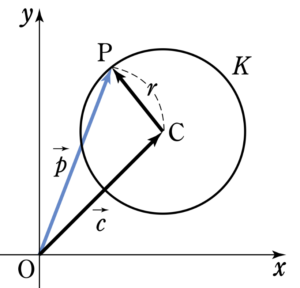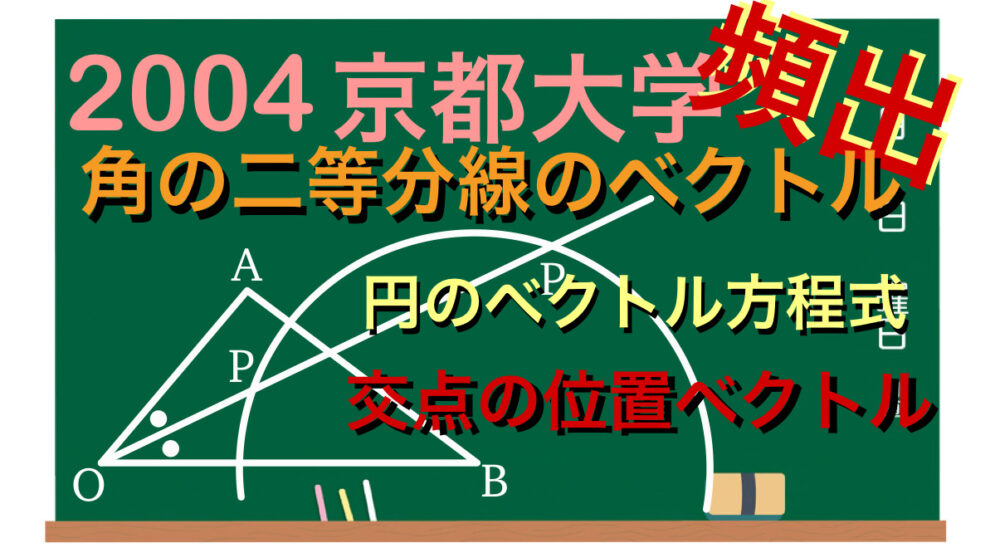【2004京都大学(文)】
\(\triangle OAB\) において,\(\overrightarrow{a}=\overrightarrow{OA}\) ,\(\overrightarrow{b}=\overrightarrow{OB}\) とする.
\(\left|\overrightarrow{a}\right|=3\) , \(\left|\overrightarrow{b}\right|=5\) , \(\cos\angle AOB=\displaystyle\frac{3}{5}\)
とする.このとき,\(\angle AOB\) の \(2\) 等分線と,\(B\) を中心とする半径 \(\sqrt{10}\) の円との交点の,\(O\) を原点とする位置ベクトルを \(\overrightarrow{a}\) , \(\overrightarrow{b}\) を用いてあらわせ.
角の二等分線のベクトル
 一直線上にない \(3\) 点 \(O\) , \(A\) , \(B\) に対して,\(\angle AOB\) の二等分線上の点を \(P\) とするとき,実数 \(t\) を用いて
一直線上にない \(3\) 点 \(O\) , \(A\) , \(B\) に対して,\(\angle AOB\) の二等分線上の点を \(P\) とするとき,実数 \(t\) を用いて
\(\overrightarrow{OP}=t\left(\displaystyle\frac{\overrightarrow{OA}}{\left|\overrightarrow{OA}\right|}+\displaystyle\frac{\overrightarrow{OB}}{\left|\overrightarrow{OB}\right|}\right)\)
※ とても有名な形です。結果を覚えておきましょう!証明等については⏬

円のベクトル方程式
 点 \(C\) ( \(\overrightarrow{c}\) ) を中心とする半径 \(r\) の円を \(K\) とする.
点 \(C\) ( \(\overrightarrow{c}\) ) を中心とする半径 \(r\) の円を \(K\) とする.
このとき,点 \(P\) ( \(\overrightarrow{p}\) ) が円 \(K\) 上にあることは,
\(|\overrightarrow{p}-\overrightarrow{c}|=r\)
と表すことができる.これを円のベクトル方程式という.
解答
交点を \(P\) とする.点 \(P\) は \(\angle AOB\) の二等分線上より実数 \(t\) を用いて,
\(\overrightarrow{OP}=t\left(\displaystyle\frac{\overrightarrow{OA}}{\left|\overrightarrow{OA}\right|}+\displaystyle\frac{\overrightarrow{OB}}{\left|\overrightarrow{OB}\right|}\right)=t\left(\displaystyle\frac{\overrightarrow{a}}{3}+\displaystyle\frac{\overrightarrow{b}}{5}\right)\) ・・・①
とおける.
また,点 \(P\) は \(B\) を中心として半径 \(\sqrt{10}\) の円上より
\(|\overrightarrow{p}-\overrightarrow{b}|=\sqrt{10}\)
①より
\(\left|\displaystyle\frac{t}{3}\overrightarrow{a}+\left(\displaystyle\frac{t}{5}-1\right)\overrightarrow{b}\right|=\sqrt{10}\)
\(2\) 乗すると
\(\displaystyle\frac{t^2}{9}\left|\overrightarrow{a}\right|^2+\displaystyle\frac{2t}{3}\left(\displaystyle\frac{t}{5}-1\right)\overrightarrow{a}\cdot\overrightarrow{b}+\left(\displaystyle\frac{t}{5}-1\right)^2\left|\overrightarrow{b}\right|^2=10\)
ここで,\(\left|\overrightarrow{a}\right|^2=3^2=9\) , \(\left|\overrightarrow{b}\right|^2=5^2=25\)
\(\overrightarrow{a}\cdot\overrightarrow{b}=3\times 5\times \displaystyle\frac{3}{5}=9\) より
代入して式を整理すると,
\(16t^2-80t+75=0\)
\((4t-5)(4t-15)=0\)
よって,\(t=\displaystyle\frac{5}{4} , \displaystyle\frac{15}{4}\)
したがって①より
\(\overrightarrow{OP}=\displaystyle\frac{5}{12}\overrightarrow{a}+\displaystyle\frac{1}{4}\overrightarrow{b}\)
\(\overrightarrow{OP}=\displaystyle\frac{5}{4}\overrightarrow{a}+\displaystyle\frac{3}{4}\overrightarrow{b}\)








コメント